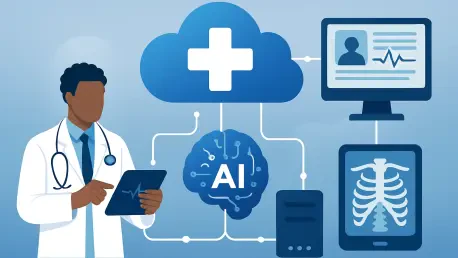In an era where healthcare faces unprecedented challenges, a small startup has emerged as a beacon of innovation by leveraging artificial intelligence (AI) and cloud computing to redefine patient care. Struggling with overwhelming data volumes and constrained resources, this company turned to advanced technology to break free from outdated, reactive approaches. By combining AI’s powerful analytical capabilities with the cloud’s unmatched scalability, they’ve introduced real-time risk prediction that empowers doctors to address health issues before they escalate. This isn’t just a single success story; it represents a transformative shift in the medical field, offering a model for how technology can enhance efficiency and save lives. As the industry grapples with rising demands, this startup’s journey highlights a path forward, demonstrating that even organizations with limited means can drive monumental change through strategic innovation.
Revolutionizing Data Management
The startup faced a daunting obstacle in handling the sheer volume of patient data pouring in daily, encompassing everything from historical medical records to real-time vitals like heart rate and blood pressure. Without sophisticated tools, analyzing this information quickly enough to make a difference was nearly impossible, often resulting in delayed responses to critical health risks. AI emerged as a vital solution, rapidly sifting through complex datasets to identify patterns and anomalies that might signal impending issues. Paired with cloud technology, which provided a reliable platform for storing and retrieving data instantly, the system enabled seamless integration of insights. This powerful combination ensured that early warning signs of conditions such as cardiovascular problems were detected promptly, allowing medical professionals to intervene with precision and speed, ultimately transforming the way patient information is processed and acted upon in high-stakes environments.
Beyond the technical feat of data processing, the integration of AI and cloud systems addressed a deeper challenge: turning raw numbers into actionable intelligence under tight time constraints. The startup’s platform didn’t just store information; it continuously analyzed live metrics to predict potential health crises before they manifested as visible symptoms. For instance, subtle fluctuations in vital signs that might indicate diabetic complications could trigger immediate notifications to healthcare providers. Cloud infrastructure supported this by ensuring data was accessible across multiple touchpoints without lag, eliminating bottlenecks that often plague traditional systems. This real-time analytical capability marked a significant departure from older methods where delays in data interpretation could mean the difference between timely care and missed opportunities, setting a new benchmark for responsiveness in healthcare technology and illustrating the profound impact of merging cutting-edge tools with practical application.
Overcoming Financial Constraints
For a startup operating on a shoestring budget, the prospect of building an extensive in-house IT infrastructure was simply unattainable, given the high costs of physical servers and maintenance. Cloud computing provided a critical workaround, offering a cost-effective alternative that didn’t require massive upfront investments. This technology allowed the company to access robust digital resources on a pay-as-you-go basis, ensuring financial flexibility while maintaining high performance. As the patient base expanded, the cloud effortlessly scaled to accommodate growing data demands without necessitating additional hardware or significant capital expenditure. This affordability and adaptability broke down traditional economic barriers, enabling a small entity to deliver sophisticated healthcare solutions that rival those of much larger, well-funded organizations in the industry.
Moreover, the scalability of cloud systems ensured that the startup could focus on innovation rather than infrastructure management, a common hurdle for resource-limited companies. With the ability to dynamically adjust backend capacity in response to fluctuating needs, the system remained resilient even as data volumes surged. This meant that whether serving a handful of patients or thousands, the technology performed consistently, avoiding the downtime or inefficiencies that often accompany rapid growth. By leveraging such a flexible framework, the startup not only conserved financial resources but also gained a competitive edge, proving that cutting-edge care doesn’t have to come with a prohibitive price tag. This approach serves as a compelling example for other emerging players in healthcare, showing how strategic technology adoption can democratize access to advanced tools and foster innovation regardless of budget size.
Enhancing Access Across Boundaries
One of the standout advantages of cloud integration was its capacity to dissolve geographical and logistical barriers in healthcare delivery, a persistent challenge in reaching patients effectively. Medical professionals could tap into patient data at any time, from any location—whether stationed in a busy urban clinic or providing care remotely from a distant site. This level of accessibility meant that critical health risks could be addressed in real time, no matter where the doctor or patient was located. Such flexibility proved invaluable in emergency scenarios, where every second counts, ensuring that life-saving decisions weren’t delayed by physical distance. By enabling this connected approach, the startup reshaped the dynamics of medical response, aligning with the growing trend of telehealth and setting a foundation for more inclusive, responsive care systems.
Additionally, the ability to access data remotely fostered a more collaborative environment among healthcare teams, enhancing overall patient outcomes. Doctors and specialists, regardless of their physical location, could review the same up-to-date information simultaneously, facilitating coordinated efforts in diagnosis and treatment planning. This was particularly beneficial for rural or underserved areas where access to on-site expertise might be limited, as cloud technology bridged the gap by bringing critical insights directly to those in need. The startup’s implementation of such a system highlighted a broader potential for healthcare delivery, where barriers of distance no longer dictate the quality or speed of care. This shift not only improved individual patient experiences but also pointed to a future where technology ensures equitable access to medical resources across diverse settings and populations.
Pioneering Predictive Care Models
Perhaps the most groundbreaking aspect of the startup’s approach was its transition from reactive treatment to a predictive model of healthcare, fundamentally altering how risks are managed. Traditional methods often waited for symptoms to surface before action was taken, frequently resulting in delayed interventions. By contrast, the AI-driven system, supported by cloud infrastructure, continuously monitored vital signs to detect anomalies—such as unexpected drops in heart rate or spikes in glucose levels—before they became critical. Instant alerts were then dispatched to medical staff, enabling preemptive measures that could avert serious health events. This proactive stance redefined patient care, emphasizing prevention over cure and positioning the startup as a leader in a movement toward smarter, anticipatory medical practices.
Further exploring this shift, the predictive capabilities of the integrated system offered a glimpse into a future where healthcare prioritizes early intervention as standard practice. By analyzing patterns in real-time data, the technology could forecast potential issues with remarkable accuracy, allowing doctors to tailor care plans to individual risks long before a problem escalated. This not only improved patient safety but also reduced the burden on emergency services by minimizing acute incidents. The cloud’s role in ensuring that these predictive insights were instantly accessible to all relevant parties amplified the impact, creating a seamless flow of information that supported timely decision-making. Such an approach underscored the transformative potential of technology in saving lives through foresight, inspiring a broader rethink of how medical systems can evolve to address challenges before they manifest as crises.
Safeguarding Trust Through Security
Navigating the complexities of handling sensitive patient information posed a significant challenge for the startup, particularly under stringent regulations like the Health Insurance Portability and Accountability Act (HIPAA). Ensuring data privacy and protection was non-negotiable, as any breach could undermine trust and carry severe consequences. To address this, the company strategically partnered with cloud providers that offered built-in compliance features and advanced encryption protocols. These measures safeguarded patient data against unauthorized access and potential loss, maintaining the integrity of the system even as it scaled. By embedding security into the core of their technological framework, the startup demonstrated that innovation and responsibility can coexist, setting a high standard for ethical advancement in the healthcare technology space.
Equally important was the assurance that security measures did not compromise the system’s efficiency or accessibility, a balance often hard to strike. The chosen cloud platforms provided robust defenses without slowing down data retrieval or analysis, ensuring that medical professionals could rely on both speed and safety in their daily operations. Regular updates and compliance checks further fortified the system against emerging threats, reflecting a commitment to continuous improvement in data protection. This meticulous attention to security not only protected patient confidentiality but also built a foundation of trust with users, a critical factor in the adoption of new technologies in healthcare. The startup’s success in this area offered a valuable lesson for others in the field: prioritizing data integrity alongside technological progress is essential for sustainable growth and credibility in an industry where trust is paramount.
Reflecting on a Technological Milestone
Looking back, the journey of this healthcare startup illustrated a pivotal moment where AI and cloud integration tackled systemic challenges with remarkable outcomes. The ability to transform overwhelming data into real-time insights, scale operations affordably, enhance accessibility, pioneer predictive care, and uphold stringent security standards reshaped patient care for the better. This achievement signaled a broader potential for technology to empower even the smallest players to effect meaningful change in medicine. Moving forward, the industry might consider how to expand access to such tools, ensuring that more providers adopt real-time systems to elevate care standards. Exploring partnerships with tech innovators and investing in training for medical staff could accelerate this shift, while ongoing emphasis on data protection will remain crucial. This case stands as a testament to what’s possible, urging stakeholders to build on these advancements for a healthier, more responsive future.









